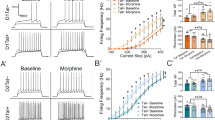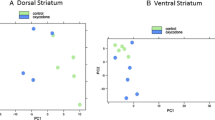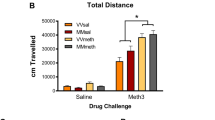Abstract
HIV-associated neurocognitive disorders (HAND) remain pervasive even with increased efficacy/use of antiretroviral therapies. Opioid use/abuse among HIV + individuals is documented to exacerbate CNS deficits. White matter (WM) alterations, including myelin pallor, and volume/structural alterations detected by diffusion tensor imaging are common observations in HIV + individuals, and studies in non-human primates suggest that WM may harbor virus. Using transgenic mice that express the HIV-1 Tat protein, we examined in vivo effects of 2–6 weeks of Tat and morphine exposure on WM using genomic and biochemical methods. RNA sequencing of striatal tissue at 2 weeks revealed robust changes in mRNAs associated with oligodendrocyte precursor populations and myelin integrity, including those for transferrin, the atypical oligodendrocyte marker N-myc downstream regulated 1 (Ndrg1), and myelin regulatory factor (Myrf/Mrf), an oligodendrocyte-specific transcription factor with a significant role in oligodendrocyte differentiation/maturation. Western blots conducted after 6-weeks exposure in 3 brain regions (striatum, corpus callosum, pre-frontal cortex) revealed regional differences in the effect of Tat and morphine on Myrf levels, and on levels of myelin basic protein (MBP), whose transcription is regulated by Myrf. Responses included individual and interactive effects. Although baseline and post-treatment levels of Myrf and MBP differed between brain regions, post-treatment MBP levels in striatum and pre-frontal cortex were compatible with changes in Myrf activity. Additionally, the Myrf regulatory ubiquitin ligase Fbxw7 was identified as a novel target in our model. These results suggest that Myrf and Fbxw7 contribute to altered myelin gene regulation in HIV.






Similar content being viewed by others
Data availability
The data that support the findings of this study are available from the authors upon reasonable request.
References
Akiyama K, Ichinose S, Omori A et al (2002) Study of expression of myelin basic proteins (MBPs) in developing rat brain using a novel antibody reacting with four major isoforms of MBP. J Neurosci Res 68:19–28. https://doi.org/10.1002/jnr.10188
Ances BM, Ortega M, Vaida F et al (2012) Independent effects of HIV, aging, and HAART on brain volumetric measures. J Acquir Immune Defic Syndr (1988) 59:469–477. https://doi.org/10.1097/QAI.0b013e318249db17
Arvidsson U, Riedl M, Chakrabarti S et al (1995) Distribution and targeting of a μ-opioid receptor (MOR1) in brain and spinal cord. J Neurosci 15:3328–3341. https://doi.org/10.1523/jneurosci.15-05-03328.1995
Balinang JM, Masvekar RR, Hauser KF, Knapp PE (2017) Productive infection of human neural progenitor cells by R5 tropic HIV-1: opiate co-exposure heightens infectivity and functional vulnerability. AIDS 31:753–764. https://doi.org/10.1097/QAD.0000000000001398
Bell JE, Arango JC, Anthony IC (2006) Neurobiology of multiple insults: HIV-1-associated brain disorders in those who use illicit drugs. J Neuroimmune Pharmacol 1:182–191. https://doi.org/10.1007/s11481-006-9018-2
Bruce-Keller AJ, Turchan-Cholewo J, Smart EJ et al (2008) Morphine causes rapid increases in glial activation and neuronal injury in the striatum of inducible HIV-1 tat transgenic mice. Glia 56:1414–1427. https://doi.org/10.1002/glia.20708
Bujalka H, Koenning M, Jackson S et al (2013) MYRF is a membrane-associated transcription factor that autoproteolytically cleaves to directly activate myelin genes. PLoS Biol 11:1001625. https://doi.org/10.1371/journal.pbio.1001625
Cai Y, Yang L, Hu G et al (2016) Regulation of morphine-induced synaptic alterations: role of oxidative stress, ER stress, and autophagy. J Cell Biol 215:245–258. https://doi.org/10.1083/jcb.201605065
Carr DJJ, Serou M (1995) Exogenous and endogenous opioids as biological response modifiers. Immunopharmacology 31:59–71. https://doi.org/10.1016/0162-3109(95)00033-6
Castellano P, Prevedel L, Eugenin EA (2017) HIV-infected macrophages and microglia that survive acute infection become viral reservoirs by a mechanism involving Bim. Sci Rep 7:1–16. https://doi.org/10.1038/s41598-017-12758-w
Chang K, Premeaux TA, Cobigo Y et al (2020) Plasma inflammatory biomarkers link to diffusion tensor imaging metrics in virally suppressed HIV-infected individuals. AIDS 34:203–213. https://doi.org/10.1097/QAD.0000000000002404
Corrêa DG, Zimmermann N, Tukamoto G et al (2016) Longitudinal assessment of subcortical gray matter volume, cortical thickness, and white matter integrity in HIV-positive patients. J Magn Reson Imaging 44:1262–1269. https://doi.org/10.1002/jmri.25263
Cysique LA, Soares JR, Geng G et al (2017) White matter measures are near normal in controlled HIV infection except in those with cognitive impairment and longer HIV duration. J Neurovirol 23:539–547. https://doi.org/10.1007/s13365-017-0524-1
Donahoe RM, Vlahov D (1998) Opiates as potential cofactors in progression of HIV-1 infections to AIDS. J Neuroimmunol 83:77–87. https://doi.org/10.1016/S0165-5728(97)00224-5
Eggers C, Arendt G, Hahn K et al (2017) HIV-1-associated neurocognitive disorder: epidemiology, pathogenesis, diagnosis, and treatment. J Neurol 264:1715–1727
Emery B, Agalliu D, Cahoy JD et al (2009) Myelin gene regulatory factor is a critical transcriptional regulator required for CNS myelination. Cell 138:172–185. https://doi.org/10.1016/j.cell.2009.04.031
Fischer CA, Morell P (1974) Turnover of proteins in myelin and myelin-like material of mouse brain. Brain Res 74:51–65. https://doi.org/10.1016/0006-8993(74)90111-5
Ge SX, Son EW, Yao R (2018) iDEP: an integrated web application for differential expression and pathway analysis of RNA-Seq data. BMC Bioinformatics 19. https://doi.org/10.1186/s12859-018-2486-6
Hall SA, Bell RP, Davis SW et al (2021) Human immunodeficiency virus-related decreases in corpus callosal integrity and corresponding increases in functional connectivity. Hum Brain Mapp 42:4958–4972. https://doi.org/10.1002/hbm.25592
Hauser KF, Hahn YK, Adjan VV et al (2009) HIV-1 Tat and morphine have interactive effects on oligodendrocyte survival and morphology. Glia 194–206. https://doi.org/10.1002/glia.20746
Heaton RK, Clifford DB, Franklin DR et al (2010) HIV-associated neurocognitive disorders persist in the era of potent antiretroviral therapy: Charter Study. Neurology 75:2087–2096. https://doi.org/10.1212/WNL.0b013e318200d727
Henderson LJ, Johnson TP, Smith BR et al (2019) Presence of Tat and transactivation response element in spinal fluid despite antiretroviral therapy. AIDS 33(Suppl 2):S145–S157. https://doi.org/10.1097/QAD.0000000000002268
Hoeck JD, Jandke A, Blake SM et al (2010) Fbw7 controls neural stem cell differentiation and progenitor apoptosis via Notch and c-Jun. Nat Neurosci 13:1365–1372. https://doi.org/10.1038/nn.2644
Huber W, Carey VJ, Gentleman R et al (2015) Orchestrating high-throughput genomic analysis with Bioconductor. Nat Methods 12:115–121. https://doi.org/10.1038/nmeth.3252
Jankiewicz M, Holmes MJ, Taylor PA et al (2017) White matter abnormalities in children with HIV infection and exposure. Front Neuroanat 11:1–9. https://doi.org/10.3389/fnana.2017.00088
Jensen BK, Monnerie H, Mannell MV et al (2015) Altered oligodendrocyte maturation and myelin maintenance: the role of antiretrovirals in HIV-associated neurocognitive disorders. J Neuropathol Exp Neurol 74:1093–1118. https://doi.org/10.1097/NEN.0000000000000255
Jensen BK, Roth LM, Grinspan JB, Jordan-Sciutto KL (2019) White matter loss and oligodendrocyte dysfunction in HIV: a consequence of the infection, the antiretroviral therapy or both? Brain Res 1724:146397
Johnson TP, Patel K, Johnson KR et al (2013) Induction of IL-17 and nonclassical T-cell activation by HIV-Tat protein. Proc Natl Acad Sci U S A 110:13588–13593. https://doi.org/10.1073/pnas.1308673110
Kamholz J, Toffenetti J, Lazzarini RA (1988) Organization and expression of the human myelin basic protein gene. J Neurosci Res 21:62–70. https://doi.org/10.1002/jnr.490210110
Karris MY, Berko J, Mazonson PD et al (2020) Association of pain and pain medication use with multiple characteristics of older people living with HIV. AIDS Res Hum Retroviruses 36:663–669. https://doi.org/10.1089/aid.2020.0039
Knapp PE, Maderspach K, Hauser KF (1998) Endogenous opioid system in developing normal and jimpy oligodendrocytes: μ and κ opioid receptors mediate differential mitogenic and growth responses. Glia 22:189–201. https://doi.org/10.1002/(SICI)1098-1136(199802)22:2%3c189::AID-GLIA10%3e3.0.CO;2-U
Koenning M, Jackson S, Hay CM et al (2012) Myelin gene regulatory factor is required for maintenance of myelin and mature oligodendrocyte identity in the adult CNS. J Neurosci 32:12528–12542. https://doi.org/10.1523/JNEUROSCI.1069-12.2012
Küper M, Rabe K, Esser S et al (2011) Structural gray and white matter changes in patients with HIV. J Neurol 258:1066–1075. https://doi.org/10.1007/s00415-010-5883-y
Langford TD, Letendre SL, Larrea GJ, Masliah E (2003) Changing patterns in the neuropathogenesis of HIV during the HAART era. In: Brain Pathology. Intern Soc Neuropathol 195–210
Lawrence DMP, Durham LC, Schwartz L et al (2004) Human immunodeficiency virus type 1 infection of human brain-derived progenitor cells. J Virol 78:7319–7328. https://doi.org/10.1128/jvi.78.14.7319-7328.2004
Lutgen V, Narasipura SD, Barbian HJ et al (2020) HIV infects astrocytes in vivo and egresses from the brain to the periphery. PLoS Pathog 16. https://doi.org/10.1371/journal.ppat.1008381
Mansour A, Fox CA, Akil H, Watson SJ (1995) Opioid-receptor mRNA expression in the rat CNS: anatomical and functional implications. Trends Neurosci 18:22–29
Mansour A, Khachaturian H, Lewis ME et al (1988) Anatomy of CNS opioid receptors. Trends Neurosci 11:308–314
Marks WD, Paris JJ, Schier CJ et al (2016) HIV-1 Tat causes cognitive deficits and selective loss of parvalbumin, somatostatin, and neuronal nitric oxide synthase expressing hippocampal CA1 interneuron subpopulations. J Neurovirol 22:747–762. https://doi.org/10.1007/s13365-016-0447-2
Martin E, Keutmann MK, Fogel JS et al (2018) Verbal and spatial working memory among drug-using HIV-infected men and women. J Neurovirol 24:488–497. https://doi.org/10.1007/s13365-018-0639-z
Masvekar RR, El-Hage N, Hauser KF, Knapp PE (2015) GSK3β-activation is a point of convergence for HIV-1 and opiate-mediated interactive neurotoxicity. Mol Cell Neurosci 65:11–20. https://doi.org/10.1016/j.mcn.2015.01.001
McCaig C, Potter L, Abramczyk O, Murray JT (2011) Phosphorylation of NDRG1 is temporally and spatially controlled during the cell cycle. Biochem Biophys Res Commun 411:227–234. https://doi.org/10.1016/j.bbrc.2011.06.092
McCarthy DJ, Chen Y, Smyth GK (2012) Differential expression analysis of multifactor RNA-Seq experiments with respect to biological variation. Nucleic Acids Res 40:4288–4297. https://doi.org/10.1093/nar/gks042
Micheva KD, Wolman D, Mensh BD et al (2016) A large fraction of neocortical myelin ensheathes axons of local inhibitory neurons. Elife 5. https://doi.org/10.7554/eLife.15784
Müller-Oehring EM, Schulte T, Rosenbloom MJ et al (2010) Callosal degradation in HIV-1 infection predicts hierarchical perception: a DTI study. Neuropsychologia 48:1133–1143. https://doi.org/10.1016/j.neuropsychologia.2009.12.015
Nakayama S, Yumimoto K, Kawamura A, Nakayama KI (2018) Degradation of the endoplasmic reticulum–anchored transcription factor MyRF by the ubiquitin ligase SCFFbxw7 in a manner dependent on the kinase GSK-3. J Biol Chem 293:5705–5714. https://doi.org/10.1074/jbc.RA117.000741
Nelson HN, Treichel AJ, Eggum EN et al (2020) Individual neuronal subtypes control initial myelin sheath growth and stabilization. Neural Dev 15. https://doi.org/10.1186/s13064-020-00149-3
ONUSIDA/UNAIDS (2020) Global HIV & AIDS statistics — 2020 fact sheet | UNAIDS. In: unaids.org. https://www.unaids.org/en/resources/fact-sheet. Accessed 8 Dec 2020
Paris JJ, Zou SP, Hahn YK et al (2016) 5α-reduced progestogens ameliorate mood-related behavioral pathology, neurotoxicity, and microgliosis associated with exposure to HIV-1 Tat. Brain Behav Immun 55:202–214. https://doi.org/10.1016/j.bbi.2016.01.007
Perez S, Johnson AM, Xiang SH, et al (2018) Persistence of SIV in the brain of SIV-infected Chinese rhesus macaques with or without antiretroviral therapy. J Neurovirol 24:62–74. https://doi.org/10.1007/s13365-017-0594-0
Pomara N, Crandall DT, Choi SJ et al (2001) White matter abnormalities in HIV-1 infection: a diffusion tensor imaging study. Psychiatry Res Neuroimaging 106:15–24. https://doi.org/10.1016/S0925-4927(00)00082-2
Rayne F, Debaisieux S, Yezid H et al (2010) Phosphatidylinositol-(4,5)-bisphosphate enables efficient secretion of HIV-1 Tat by infected T-cells. EMBO J 29:1348–1362. https://doi.org/10.1038/emboj.2010.32
Rodríguez Salgado D, Rodríguez Álvarez M, Seoane Pesqueira G (2006) Neuropsychological impairment among asymptomatic HIV-positive former intravenous drug users. Cogn Behav Neurol 19:95–104. https://doi.org/10.1097/01.wnn.0000182832.54697.5c
Sabin CA, Harding R, Doyle N et al (2020) Associations between widespread pain and sleep quality in people with HIV. J Acquir Immune Defic Syndr 85:106–112. https://doi.org/10.1097/QAI.0000000000002410
Schier CJ, Marks WD, Paris JJ et al (2017) Selective vulnerability of striatal D2 versus D1 dopamine receptor-expressing medium spiny neurons in HIV-1 tat transgenic male mice. J Neurosci 37:5758–5769. https://doi.org/10.1523/JNEUROSCI.0622-17.2017
Shapira R, Wilhelmi MR, Kibler RF (1981) Turnover of myelin proteins of rat brain, determined in fractions separated by sedimentation in a continuous sucrose gradient. J Neurochem 36:1427–1432. https://doi.org/10.1111/j.1471-4159.1981.tb00582.x
Song L, Nath A, Geiger JD et al (2003) Human immunodeficiency virus type 1 Tat protein directly activates neuronal N-methyl-D-aspartate receptors at an allosteric zinc-sensitive site. J Neurovirol 9:399–403. https://doi.org/10.1080/13550280390201704
Steadman PE, Xia F, Ahmed M et al (2020) Disruption of Oligodendrogenesis Impairs Memory Consolidation in Adult Mice in Brief. https://doi.org/10.1016/j.neuron.2019.10.013
Stiene-Martin A, Knapp PE, Martin K et al (2001) Opioid system diversity in developing neurons, astroglia, and oligodendroglia in the subventricular zone and striatum: impact on gliogenesis in vivo. Glia 36:78–88. https://doi.org/10.1002/glia.1097
Stubbe-Drger B, Deppe M, Mohammadi S et al (2012) Early microstructural white matter changes in patients with HIV: a diffusion tensor imaging study. BMC Neurol 12. https://doi.org/10.1186/1471-2377-12-23
Tate DF, Conley J, Paul RH et al (2010) Quantitative diffusion tensor imaging tractography metrics are associated with cognitive performance among HIV-infected patients. Brain Imaging Behav 4:68–79. https://doi.org/10.1007/s11682-009-9086-z
Tomassy GS, Berger DR, Chen HH et al (2014) Distinct profiles of myelin distribution along single axons of pyramidal neurons in the neocortex. Science (1979) 344:319–324
Tomassy GS, Dershowitz LB, Arlotta P (2016) Diversity matters: a revised guide to myelination. Trends Cell Biol 26:135–147
Vogel BE, Lee SJ, Hildebrand A et al (1993) A novel integrin specificity exemplified by binding of the α(v)β5 integrin to the basic domain of the HIV Tat protein and vitronectin. J Cell Biol 121:461–468. https://doi.org/10.1083/jcb.121.2.461
Watson C, Busovaca E, Foley JM et al (2017) White matter hyperintensities correlate to cognition and fiber tract integrity in older adults with HIV. J Neurovirol 23:422–429. https://doi.org/10.1007/s13365-016-0509-5
Xiao H, Neuveut C, Tiffany HL et al (2000) Selective CXCR4 antagonism by Tat: implications for in vivo expansion of coreceptor use by HIV-1. Proc Natl Acad Sci U S A 97:11466–11471. https://doi.org/10.1073/pnas.97.21.11466
Yang Y, Zhou X, Liu X et al (2021) Implications of FBXW7 in neurodevelopment and neurodegeneration: molecular mechanisms and therapeutic potential. Front Cell Neurosci 15
Yin P, Liu Q, Pan Y et al (2020) Phosphorylation of myelin regulatory factor by PRKG 2 mediates demyelination in Huntington’s disease . EMBO Rep 21. https://doi.org/10.15252/embr.201949783
Zhang Y, Chen K, Sloan SA et al (2014) An RNA-sequencing transcriptome and splicing database of glia, neurons, and vascular cells of the cerebral cortex. J Neurosci 34:11929–11947. https://doi.org/10.1523/JNEUROSCI.1860-14.2014
Zonouzi M, Berger D, Jokhi V et al (2019) Individual oligodendrocytes show bias for inhibitory axons in the neocortex. Cell Rep 27:2799-2808.e3. https://doi.org/10.1016/j.celrep.2019.05.018
Zou S, Balinang JM, Paris JJ et al (2019) Effects of HIV-1 Tat on oligodendrocyte viability are mediated by CaMKIIβ–GSK3β interactions. J Neurochem 149:98–110. https://doi.org/10.1111/jnc.14668
Zou S, Fitting S, Hahn Y-K et al (2011) Morphine potentiates neurodegenerative effects of HIV-1 Tat through actions at m-opioid receptor-expressing glia. Brain 3613–3628. https://doi.org/10.1093/brain/awr281
Zou S, Fuss B, Fitting S et al (2015) Oligodendrocytes are targets of HIV-1 tat: NMDA and AMPA receptor-mediated effects on survival and development. J Neurosci 35:11384–11398. https://doi.org/10.1523/JNEUROSCI.4740-14.2015
Zuchero JB, Barres BA (2013) Intrinsic and extrinsic control of oligodendrocyte development. Curr Opin Neurobiol 23:914–920
Author information
Authors and Affiliations
Corresponding author
Ethics declarations
Conflict of interest
The authors declare no competing interests.
Additional information
Publisher's Note
Springer Nature remains neutral with regard to jurisdictional claims in published maps and institutional affiliations.
Supplementary Information
Below is the link to the electronic supplementary material.
Rights and permissions
Springer Nature or its licensor (e.g. a society or other partner) holds exclusive rights to this article under a publishing agreement with the author(s) or other rightsholder(s); author self-archiving of the accepted manuscript version of this article is solely governed by the terms of such publishing agreement and applicable law.
About this article
Cite this article
Flounlacker, K.M., Hahn, Y.K., Xu, R. et al. Myelin regulatory factor is a target of individual and interactive effects of HIV-1 Tat and morphine in the striatum and pre-frontal cortex. J. Neurovirol. 29, 15–26 (2023). https://doi.org/10.1007/s13365-022-01107-x
Received:
Revised:
Accepted:
Published:
Issue Date:
DOI: https://doi.org/10.1007/s13365-022-01107-x




